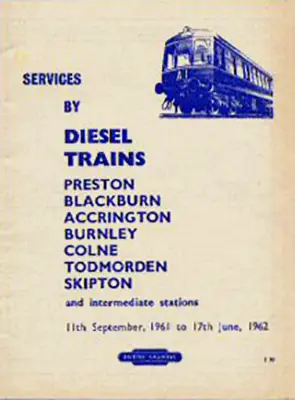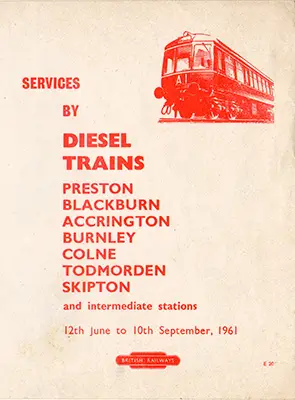DMU Operations: London Midland Region
Preston - Colne
DMUs were introduced to the services as last phase of the North East Lancashire (Manchester Part 3) diesel scheme on the 6th March 1961. The same section of the route was also covered by Blackpool - Colne and Preston - Skipton DMUs.
Rolls-Royce powered Cravens sets (Class 112/3s) would initially be the main sets used. These would be replaced by conventional Cravens power twins (Class 105s), followed in the early 1980s by Class 104s and 108s. As the photos show the odd interloper could be found: a Class 100; Class 101; Class 116; and Class 120s. Second generation sets took over in the early 1990s.
Sample Timetables
These stapled booklets covered a number of other services such as Preston - Skipton and Preston - Todmorden. All measured 4 1/2" x 6" when folded.
6th March to 11th June, 1961

Cover only shown
11th September, 1961 to 17th June, 1962

Cover only shown
7th September, 1964 to 13th June, 1965

Cover only shown
Images

16th March 1968
A Rolls-Royce powered Cravens DMU with hydraulic transmission (later a Class 113) with a Colne service on 16 March 1968. Seen approaching Hospital Crossing the the east of Bamber Bridge station, Brindle Road Crossing can be seen at the other side of the bridge. Stuart Mackay Collection.

circa late 1960s
A two-car Rolls-Royce powered Cravens DMU on a Preston - Colne service at Hoghton, near Chapel Lane bridge. Date unknown - circa late 1960s. Accrington allocated M51778 leads, it was withdrawn in April 1969. Stuart Mackay Collection.

circa March 1975
A Cravens Class 105 power twin in Colne station. The slide process date was March 1975. Stuart Mackay Collection.

April 1976
Cravens Local Passenger Class 105 "power twin" 2-car dmu Nos.M50777 (105/2 ex-3-car set with one piece headcode), M50810 (105/1) of the 1957 batch, in Rail Blue livery with all-yellow front end arriving at Accrington on a Colne - Blackburn - Preston service, 04/76. Hugh Llewelyn.

April 1976
Accrington station, originally built by the East Lancashire Railway in 1848, but little of it remained by the time this was taken in 04/76. A Cravens Local Passenger Class 105 "power twin" 2-car dmu (note the grey covering over the route indicator) is seen arriving on a Preston - Blackburn - Colne service. Hugh Llewelyn.

April 1976
Cravens Local Passenger Class 105 "power twin" 2-car dmu Nos.M50809 and M50776 departing Accrington on a Colne - Blackburn - Preston service, April 1976. Hugh Llewelyn.

16th April 1976
A Class 105 power twin departs from Colne on 16 April 1976. Michael Mensing.

25th June 1976
A two-car Cravens set is seen in Colne station on June 25, 1976 with the 8.45am Preston service. Michael Mensing.

16th September 1976
A Class 105 power twin departs from Huncoat with the 13:32 Preston - Colne service on 16 September 1976. Michael Mensing.

16th September 1976
A Cravens power-twin heading for Preston at Hapton on 16 September 1976. Michael Mensing.

16th September 1976
A Cravens power-twin departs from Hapton station with a Colne - Preston service on 16 September 1976. Michael Mensing.

16th September 1976
A Class 105 power twin in Hapton station with a Preston - Colne service on 16 September 1976. Michael Mensing.

16th September 1976
A Class 105 power-twin arrives into Rose Grove station on 16 September 1976. Preston is on the blind, probably on a service from Colne. Michael Mensing.

Unknown date
A two-car Class 104 DMU, M50467 closest, departs from Preston for Colne circa early 1980s. Stuart Mackay Collection.

9th July 1977
Two Class 105 DMUs (the closest being a power-twin) at Chaffers Siding, east of Nelson, with the 11:45 Colne-Preston service on 9 July 1977. Michael Mensing.

25th July 1977
Under a threatening sky, a Cravens Class 105 Power-Twin 2-car DMU with DMCL M50801 leading, was stood at Bamber Bridge with a Colne to Preston service on July 25th 1977. The Power-Twin Class 105 fleet allocated to Newton Heath Depot were the mainstay of services in East Lancashire during the 1970's. Martyn Hilbert.

23rd June 1978
Standing amongst the Rhodendrons, A Cravens Class 105 Power-Twin with M50810 trailing, calls at Pleasington whilst working the 11.45 Preston to Colne service on June 23rd 1978. The small station at rural Pleasington became a request stop in May 2012. Martyn Hilbert.

27th January 1979
On a bright Winter day, A Cravens Class 105 power-twin with Driving Motor Composite Lavatory M50801 at the rear, was stood at Bamber Bridge with a Preston to Colne service on January 27th 1979. On that cold day that Cravens would have no doubt been warm on the inside, complete with its oily/diesel smell aroma. What price now a ride to Colne in first class with a view of the line through the rear cab? Martyn Hilbert.

27th January 1979
Deep & Crisp and Even at Bamber Bridge as a Cravens Class 105 Power Twin formed of Driving Motor Composite Lavatory (DMCL) M50788 and Driving Motor Brake Second (DMBS) M50761, was approaching the station with a Preston to Colne service on January 27th 1979. The Newton Heath allocated Cravens Power Twin fleet dominated these services from the late 1960's through the 1970's and into early 1980's. Martyn Hilbert.

27th January 1979
Complete with its Paraffin tail lamp, a Newton Heath allocated Cravens Class 105 Power-Twin formed of cars M50761 & M50788, was stood at a snowy Bamber Bridge with a Preston to Colne service on January 27th 1979. The Cravens Power-Twins were synonymous with the ex L&Y routes in Lancashire and Greater Manchester from the late 1960's until their demise in the early 1980's. Martyn Hilbert.
Aylesbury - London
Aylesbury - Princes Risborough
Banbury - London
Bangor - Amlwch
Bedford - Bletchley
Bedford - Northampton
Bedford - London
Birmingham - Barnt Green
Birmingham - Derby
Birmingham - Four Oaks
Birmingham - Leamington Spa Ave
Birmingham - Lichfield
Birmingham - Manchester
Birmingham - Redditch
Birmingham - Rugeley
Blackpool Sth - Kirkham & Wesham
Bury - Bacup
Bury - Rawtenstall
Carlisle - Barrow
Carlisle - Silloth
Carlisle - Skipton
Coventry - Birmingham
Crewe - Derby
Derby - Matlock
High Wycombe - London
Kentish Town - Barking
Leamington Spa - Nuneaton
Leicester - Birmingham
Leicester - Nottingham
Liverpool - Warrington C.
Llandudno - Blaenau Ffestiniog
Machynlleth - Pwllheli
Manchester - Accrington
Manchester - Blackpool
Manchester - Buxton
Manchester - Chester
Manchester - Crewe
Manchester - Hayfield
Manchester - Hunts Cross
Manchester - Llandudno
Manchester - Macclesfield C.
Manchester - Macclesfield H Rd.
Manchester - New Mills
Manchester - Leeds
Manchester - Rochdale
Manchester - Rose Hill Marple
Manchester - Royton
Manchester - Stoke-on-Trent
Nottingham - Derby
Nottingham - Lincoln
Oxenholme - Windermere
Oxford - Cambridge
Penrith - Workington
Preston - Blackpool - Fleetwood
Preston - Colne
Redditch - Four Oaks
Shrewsbury - Aberystwyth
Shrewsbury - Wolverhampton
Stockport - Stalybridge
Watford - St Albans
Whitehaven - Workington - Carlisle
Wrexham - Chester - New Brighton





